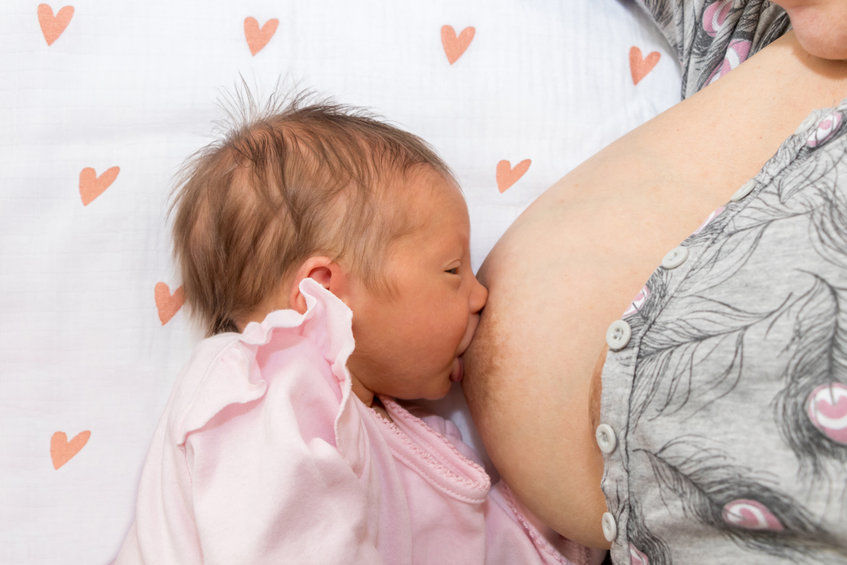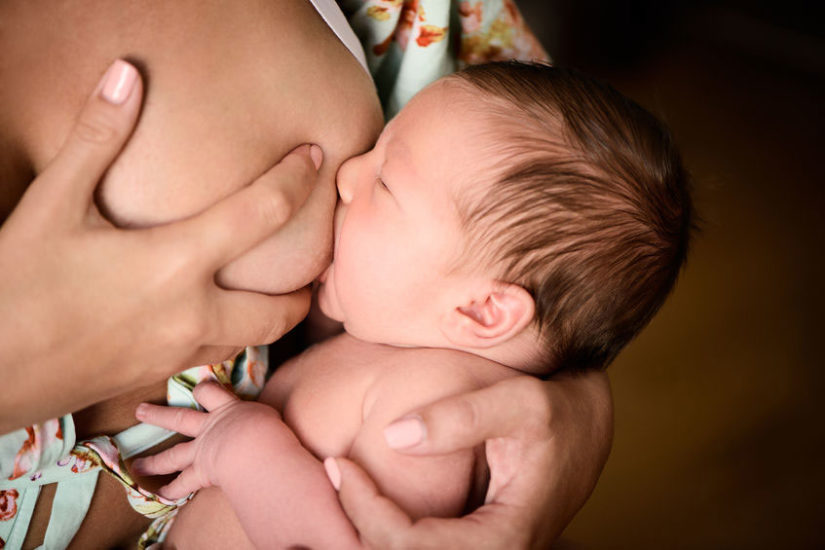Breastfeeding can run smoothly with all sizes of breast. However, large breasts may make it more challenging to position baby comfortably, or to find nursing bras, pump flanges or nipple shields in larger sizes. This article shares tips for breastfeeding with large breasts and looks at common concerns larger breasted women can have when breastfeeding.
Breastfeeding positions for larger breasts
Our articles Breastfeeding Positions for Newborns and Latching Tips have general information to help a baby attach (latch) comfortably to the breast with a big mouthful of breast tissue as well as a nipple. These should be read alongside the specific breastfeeding tips for the larger breasted mother in this article.
General positioning tips
- Supporting the breast. Finding positions that support a larger breast throughout the feed can help prevent the weight of the breast from pulling out of a baby’s mouth causing him to slide onto the nipple (a shallow latch) or let go of the breast altogether. Supporting the breast also prevents a heavy breast from pressing on baby’s chest.1 Breast support may be achieved in a number of ways (see below), examples include reclining so the breasts are supported by the body, using hands to support the breast, side-lying or using a rolled towel under the breast.
- Pillows and stools. A commercial breastfeeding pillow is unlikely to be needed to lift your baby to breast height in cross cradle or cradle hold if your breasts hang low in your lap, but pillows can be useful to support your arms, back or breast. A chair without arms may be helpful to provide enough space to get comfortable. Bending the knees slightly and resting your feet on a low footstool may also be useful to get comfortable.
Traditional holds with larger breasts
As each mother and baby’s anatomy are slightly different, a breastfeeding position that works for one may not work for another, whatever the size of breast. There are several positions to try but if you are finding positioning difficult, a breastfeeding specialist such as an IBCLC lactation consultant is an ideal partner to help you.
#1 Cradle hold
In cradle hold, baby is held in the crook of one arm and feeds from the breast on the same side. For a larger breasted mother, a modified cradle hold with baby supported on mother’s forearm or wrist area can work well and leaves the opposite hand free to help shape or support the breast if needed. Your baby’s arms can cradle the breast or one arm might reach around your waist. Breast support can be achieved by using the crook of the arm, tummy, pillow, rolled towel or hand under the breast depending on your anatomy. UK lactation consultant Lucy Webber IBCLC shares her technique for breastfeeding with large breasts in cradle hold in the following short clip. In the video Lucy uses the crook of her arm to support the weight of the breast and the flat of her hand on the top of the breast to shape the breast for the latch.
Some mothers may prefer to use a hand to support the breast with thumb lightly resting on top of the breast and fingers supporting it below. Another option depending on size, is a scissor hold or V-hold where the fingers of one hand hold the breast between them. When using hands to support the breast it is important to keep fingers far enough away from the nipple so they don’t disturb baby’s attachment. The hands can also be used to shape the breast to help a baby latch as well as for support (see latching tips and helping baby to latch below).
- Advantage: In cradle hold your lap or tummy can often support your breasts so that you can concentrate on keeping baby close with nose level to nipple before he gapes wide to latch on.
- Disadvantage: It may give you less control for helping baby latch.
#2 Laid back positions
In laid back or reclining positions a baby is supported on the mother’s body in full body contact and the breasts are also supported by the mother’s body. Baby could be lying at almost any angle that works, including sitting astride his mother’s thigh (called a laid back straddle hold).
Advantages
- Laid back positions and some skin-to-skin contact help a baby use his feeding reflexes for self-latching.
- Reclining into your chair opens up the space in your lap for your baby.
- Leaning backwards can allow breast tissue to flatten slightly so that it falls away from a baby’s nose instead of surrounding it.
- The weight of the breast is not on baby’s chest.
Disadvantages
- Leaning back too far may mean that your breasts flop to the sides of your body into your armpits which can make latching more difficult.
- Laid back positions may feel more awkward for a larger breasted woman as she may not be able to see how her baby is latching behind the curve of her breasts.

In the following video, lactation consultant Nancy Mohrbacher chats to a mother as she breastfeeds in a laid back or reclining position. The mother’s body supports her breasts. Some mothers may find they still prefer to support their breasts with a hand in this position, or that the position doesn’t suit them.
#3 Rugby hold
In rugby (clutch or football) hold, baby is supported under mother’s arm at breast height. Depending on her natural breast height a mother may or may not need to lift her baby on a pillow so that baby’s nose is level with the nipple prior to latching. A rolled cloth or towel can be placed under the breast if needed for support.
- Advantage: This position leaves a hand free to help shape the breast for an assisted latch (see below), for breast compressions or to support the breast throughout the feed if needed.
- Disadvantage: A heavy breast should not rest on your baby’s chest—but this could be an issue in rugby hold. Adjust your baby’s position as needed or support the breast throughout the feed.

#4 Side-lying
Breastfeeding lying on your side so that the mattress (or floor) supports the breast can be a comfortable position. In the image below, moving baby a little further down the bed and bringing their body closer to mum will help to bring contact between the chin and the breast so that the nose is clear of breast tissue.
Advantages
- The weight of the breast is supported by the mattress.
- Some larger breasted women can breastfeed from both the upper and lower breast from a side-lying position without switching sides.
Disadvantage
- It can take a little practice to latch a baby lying down with any sized breast. Latching baby in a semi laid back position and then sliding down with baby and breast in the same position can work for some mothers.


#5 Using a table or flat surface
Some mothers have found sitting at a table to breastfeed, where the table supports both baby and the weight of the breast, recreates a side-lying position without lying down. Using a suitable breastfeeding pillow can create a similar more flexible position.
- Advantage: The weight of the breast is supported by the table or pillow.
- Disadvantage: The supporting surface needs to be at the right height with good back support for mum.

#6 Cross cradle
Cross cradle involves holding your baby using the opposite arm to the side of the breast that is being fed from—with your hand across baby’s shoulders. Your other hand is free to shape and support the breast for the latch.
- Advantage: Cross cradle can give often give good control for an “assisted latch” (see below).
- Disadvantage: Cross cradle can pose a challenge for a larger breasted mother if her arms cannot reach around baby and breast.
Tips for good attachment
The “latch” describes how a baby attaches to the breast once they are in one of the comfortable breastfeeding positions above. As with any sized breast, a baby needs to have a big deep mouthful of breast tissue as well as the nipple. This ensures breastfeeding is comfortable for you and that your baby can get plenty of breast milk. Our related article Latching Tips describes how to get a comfortable latch.
Nose to nipple
General advice to position your baby nose to nipple before he gapes to latch, may be difficult for the larger breasted woman if she cannot see her nipple without lifting or adjusting her breast. However moving a breast to the left or right from its natural resting place to reach the baby will mean it tends to pull out of your baby’s mouth during a feed when it tries to return to its usual position. If it is difficult to bring baby to the nipple due to their position, supporting the breast through the feed can help with this natural movement.
Helping baby to latch
Babies are often able to latch on all by themselves using their feeding reflexes once they are held in a comfortable breastfeeding hold, especially in reclining positions. If more help is needed see the ideas below and see Latching Tips for more guidance:
- Shaping or flattening the breast with your thumb and fingers placed around the breast behind the nipple can help baby get a deeper latch. This is sometimes called an “assisted latch”. Depending on where you put your fingers on the breast and the shape made between the fingers and thumb you may also hear it called a C-hold /U-hold or a scissor-hold/v-hold. The goal is to flatten the breast in the same way that you might flatten a big salad filled sandwich or burger in a bun to fit your mouth before you take a bite. Exactly where your fingers press on the breast to flatten it, so the “sandwich” is smaller and not fatter, will depend on the position you hold your baby in and which direction their mouth is coming from.
- An asymmetric latch. When a baby is breastfeeding well they have more of the breast tissue below the nipple in their mouth than the breast above it and this is called an asymmetric latch (off centre). If needed a baby can be helped to latch asymmetrically by shaping the breast with finger pressure behind the nipple to make the nipple point upwards as baby latches. You may hear this called the “flipple”, “exaggerated latch” or “nipple flick”.
- Keep fingers clear. Remember to keep your fingers sufficiently far from the latch so your baby can get a big mouthful of breast.
- A rolled cloth or towel placed under the breast can help adjust breast height or alter the shape of the breast to help latching. Sometimes the cup of a nursing bra can be tucked under the breast to provide support or some mothers have made a breast support from a loop of stretchy material (eg the leg from an old pair of tights). Worn around the neck like a necklace your breast can be slipped into the “sling” created.
Large nipples
Nipples come in many shapes and sizes, they increase in size during pregnancy and during breastfeeding a nipple can extend to twice its length. An average nipple diameter might be 16mm-17.5mm2 and many will fall in a range between 16 and 23mm diameter3.
Particularly large diameter nipples may fill a baby’s mouth without leaving room for any breast. If a baby is only latched to the tip of the nipple it will make it difficult for your baby to keep milk flowing and will likely cause painful, sore nipples. Whether there will be any problems for your baby if your nipples are much larger or longer than average will depend on the size of your baby’s mouth, and how stretchy or how long the nipple is. A breastfeeding specialist may be able to offer suggestions to help your baby latch more comfortably. In time, baby will grow and his mouth will better fit the nipple.
Flat nipples
As a baby breastfeeds rather than nipple feeds they are capable of breastfeeding with lots of different shapes and sizes of nipple. However some babies find flat nipples more challenging. For help with this see Breastfeeding With Inverted Nipples and Flat Nipples. Nipple shields (silicone covers with holes to protect the nipple) are sometimes used by mothers with flat nipples however they tend to come in sizes that cater for average nipples. See Nipple Shields Good or Bad? for information about sizes and brands of nipple shield and how to use them if needed.
Disappearing nipples
If breasts get engorged, nipples can quickly flatten out and literally seem to disappear making it more difficult for your baby to latch. This disappearance is temporary. Shaping the breast, expressing a little milk to bring out the nipple, or reverse pressure softening can help: see Engorged Breasts for further information.
Pumping to protect milk supply
Until baby’s mouth has grown (a week or two can make a big difference), or if you are experiencing any difficulties breastfeeding, it can be helpful to express your breast milk to keep your milk supply stimulated and your baby well fed until they can breastfeed more comfortably. Milk can be expressed by hand or pump. Choose a pump that has a large enough flange (the part of the pump that is held against the breast) and nipple tunnel (the opening over the nipple). If the nipple tunnel is too small the nipple may rub along its sides causing cracking at the base of the nipple, grazing on the nipple tip (Wilson-Clay and Hoover, 2017) or it may compress milk ducts and slow milk flow 4. The following article has much more information on choosing a breast pump and the different sizes of flange available: How to Increase Milk Supply When Pumping.

Common concerns
#1 Are my breasts a suffocation risk?
Some mothers may feel concerned that their breasts could be a suffocation risk for their baby, either from the weight of the breast on their baby or a concern that baby can’t breathe easily when buried in a very large soft breast. Always check your positioning very carefully while breastfeeding and note the following tips:
- Leaning back slightly can allow the breast tissue to fall away from a baby’s nose and with baby in a prone position (on their tummy) the weight of the breast will be under baby not on top of them.
- Holding or supporting the breast will take the weight off a baby in cradle, cross cradle or rugby hold and will also allow some breast shaping to ensure your baby’s nose is free needed.
- Where breasts are very soft and large, a baby’s nose can be kept clear of breast tissue by pressing a thumb or finger into the breast adjacent to their nose.
- Bringing baby’s chin closer to the breast by adjusting their body position slightly may help to increase the space between breast tissue and baby’s nose.


#2 Will large breasts mean too much milk?
It is not possible to predict the amount of milk making tissue in the breast by size alone since breast size is mostly determined by the amount of fat present in the breast. Large breasts are therefore not necessarily a sign of more milk compared to smaller breasts5 and large breasts do not necessarily have a larger storage capacity (the amount of milk a breast can hold).
Plenty of milk
Some mothers with large breasts will have plenty of glandular tissue and lots and lots of milk. They may feel quite swamped with milk, finding it leaks and spurts like a tap. They may find they keep getting engorged and avoiding blocked ducts and preventing mastitis can seem like a losing battle if a baby can’t keep up with the flow.
- To help your supply regulate to your baby’s needs, have a look at Oversupply of Breast Milk.
- Expressing enough milk to stay comfortable and ensuring your baby finishes the first breast before offering the second is usually helpful.
- Regular gentle massage of any areas of the breast that are not getting fully drained may help avoid engorgement. Massage should be as gentle as stroking a cat or applying cream to the skin. With moderately large or pendulous breasts the lactation tissue may be further back in the breast and harder to relieve by hand expression, massage or pump.
Obesity and milk supply
Overweight or obese women with larger breasts and a body mass index (BMI) greater than 26 may be at risk of delayed onset of lactation or a low milk supply.6 7 They may have other challenges associated with obesity such as increased risk of caesarean and postpartum oedema which can affect breastfeeding too.8 For further information about obesity and milk supply see No Breast Milk After Delivery. To ensure breastfeeding gets off to a good start, hand expressing within the first hour of birth can help with milk supply and contact an IBCLC lactation consultant or breastfeeding specialist.
Not enough milk
There are lots of ways to increase a milk supply see Reasons for Low Milk Supply and How to Make More Breast Milk.
Implants
For information about milk supply for mothers who have had breast implants see Breastfeeding With Implants.
#3 How can I breastfeed in public?
Larger breasted ladies may feel they have to expose more of their body than they are comfortable with when breastfeeding—making breastfeeding in public daunting for them. Wearing under layers, large stretchy vests that can be pulled down to keep a tummy covered or a man’s vest with arm holes large enough to bring a breast through may be helpful. If the rugby hold works well for you, some mothers use their baby changing bag or a rolled up coat to rest the baby on instead of taking a pillow everywhere they go.
#4 Where can I find a good nursing bra?
It can be a challenge to find a good fitting maternity bra in larger sizes. It is important that bras fit properly during lactation so that any seams or edges are not cutting into breast tissue and are well back in the arm pit behind the glandular tissue. Anything cutting into the breast including underwired bras could be a risk factor for mastitis or blocked ducts.
- Some mothers have converted their favourite non-maternity bra into a nursing bra (you can search online for ways to do this).
- Shopping online may offer more choice than department stores. Larger sizes are stocked by bras4mums (UK), bravissimo.com and amplebosom.com.
- See Nursing Bras FAQ for further general information about nursing bras.
Night bras
A large breasted mother may feel more comfortable at night if she wears a bra. Be wary of wearing a bra at night that is too tight or cuts into the breast tissue as this could cause blocked ducts or mastitis. Look for a lightweight stretchy cotton sleep bra that holds breast pads in place if needed and provides gentle support.
#4 Why am I getting rashes and itches?
Mothers with larger breasts may find they get very hot and have heat rashes or outbreaks of thrush in the folds beneath their breasts. And some mothers find stretch marks on their breasts can itch. Cotton bras and fabrics next to the breast can help with air circulation along with keeping the area cool, clean and dry.
#5 How much bigger will breasts get during lactation?
Some mothers find their breasts increase about two cup sizes during pregnancy ready for breastfeeding. Others may note a size increase of five cup sizes or more giving rise to unexpectedly large, or larger, breasts. In most cases after lactation, breasts will return to their original size, some may be a little smaller or larger.
Gestational gigantomastia
Rarely, a mother experiences something called gestational gigantomastia—extreme breast tissue overgrowth during pregnancy. This can make breastfeeding difficult or even impossible because of the size and weight of the breasts. Breasts can spontaneously return to normal size after the birth but in some cases surgical intervention by breast reduction may be needed.9
Considering breast reduction
For women considering breast reduction, breastfeeding after breast reduction surgery is possible. However, whether or not a mother can make a full supply of breast milk after surgery will depend on the type of surgery involved and how much functional tissue was removed. For more information about breast reduction surgery see Breast Reduction and Breastfeeding.
Summary
Breastfeeding with large breasts may present a few extra challenges for mother and baby. However, with good breastfeeding help to find the right position, or a little time for a baby’s mouth to grow to fit the breast, mother and baby can soon master breastfeeding.

